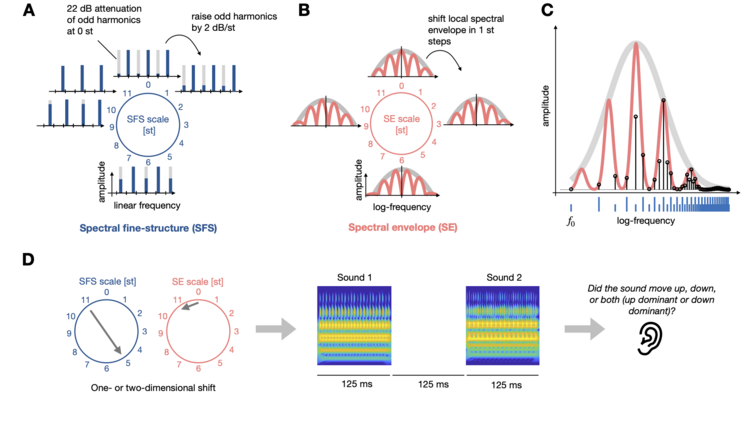Conflicting spectral cues
Funding

Conflicting spectral cues
In Siedenburg, Graves, & Pressnitzer (2022), we explore a unifying hypothesis regarding the interaction of spectral fine-structure and spectral envelope cues, commonly understood to affect pitch and brightness perception. We use Generalized Shepard tones with harmonic and inharmonic spacing of partials to address these issues.
Experiment 1: One-dimensional shifts [st]
Did the sound move up or down?
Harmonic
| SFS 1 | SFS 6 | SFS 11 | |||
| SE 1 | SE 6 | SE 11 | |||
Inharmonic
| SFS 1 | SFS 6 | SFS 11 | |||
| SE 1 | SE 6 | SE 11 | |||
Exp. 2: Two-dimensional shifts [st]
Did the sound move up, down, both (up dominant), or both (down dominant)?
Harmonic
| SFS 1 - SE 1 | SFS 6 - SE 1 | SFS 11 - SE 1 | |||
| SFS 1 - SE 6 | SFS 6 - SE 6 | SFS 11 - SE 6 | |||
| SFS 1 - SE 11 | SFS 6 - SE 11 | SFS 11 - SE 11 | |||
Inharmonic
| SFS 1 - SE 1 | SFS 6 - SE 1 | SFS 11 - SE 1 | |||
| SFS 1 - SE 6 | SFS 6 - SE 6 | SFS 11 - SE 6 | |||
| SFS 1 - SE 11 | SFS 6 - SE 11 | SFS 11 - SE 11 | |||
Exp 3: One- & two-dimensional shifts with log-spaced partials
Did the sound move up, down, both (up dominant), or both (down dominant)?
Log-equidistant
| SFS 1 - SE 1 | SFS 6 - SE 1 | SFS 11 - SE 1 | |||
| SFS 1 - SE 6 | SFS 6 - SE 6 | SFS 11 - SE 6 | |||
| SFS 1 - SE 11 | SFS 6 - SE 11 | SFS 11 - SE 11 | |||
Sequences with antagonistic cues
Here are some longer sequences with SFS and SE moving in opposing directions
| Harmonic SFS down - SE up | Inharmonic SFS down - SE up | Harmonic SFS up - SE down | Inharmonic SFS up - SE down | ||

